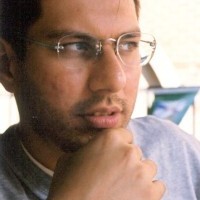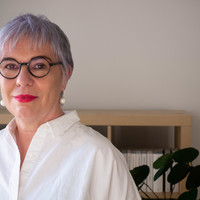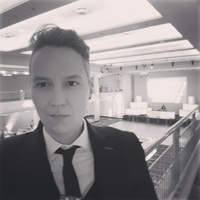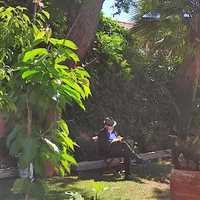
Himadri Roy
Phone: +91-11-29571615
Address: School of Gender and Development Studies, Block # 15 B, Indira Gandhi National Open University, Maidan Garhi, New Delhi --110068
Address: School of Gender and Development Studies, Block # 15 B, Indira Gandhi National Open University, Maidan Garhi, New Delhi --110068
less
Related Authors
Murat Akser
University of Ulster
Andrea Peto
Central European University
David Seamon
Kansas State University
Skadi Loist
Filmuniversitaet Babelsberg Konrad Wolf
Shilpa Phadke
Tata Institute of Social Sciences
Stephen Whittle
Manchester Metropolitan University
Catherine Grant
Birkbeck College, University of London
Francisco Vazquez-Garcia
Universidad de Cadiz
Andrea Pinotti
Università degli Studi di Milano - State University of Milan (Italy)
Mauro Grondona
University of Genova
InterestsView All (13)










Uploads
Books by Himadri Roy
LGBTQ+ community, while the vernacular media tried to keep their pace up with the contemporary artistic space.
But Bangla bhasha has always excelled in representing the LGBTQ+ community in its literary, visual and fine arts.
The queer gaze in the representation did internalise the arts beyond its surrealism and transformed the
objectification into subjectifying the queer identity in Bangla. Whether in literature, like Holde Golap or Chhayar
Prashad, or Uttaran, or in films, like Arekti Premer Golpo or Nagarkirtan, or queer fine artists, like Anup Let,
Sawaan Taank, or others — all creative artists have interchangeably used the LGBTQ+ icons, symbols or sub-
cultures to create an ambience of acceptance of not only memories, feelings, impressions, perceptions and names;
but also formulate a meta-narrative of recognition, reconstruction, and renegotiation of queerness that exists in
West Bengal. Queering the heteronormative patriarchal mainstream creative art of all forms has always been the
main intention of representation, but beyond such representation, queer performativity of inclusion, prototyping
personagraphy of the queer people in the socio-cultural structure are also subjectified. This paper tries to probe into
such cartographies of representations of expressions and experiences that question not only the heterosexual
conformism, but also criticises the inclusivity and unified subjectivity of all members of the community within the
queer rubric through examination of literary/cinematic/artistic texts available in Bangla, in the context of
consuming cultures through post-individual, post-body and post-class of the Bengali society.
Papers by Himadri Roy
My paper will be probing into the pre-judgment cruising areas for gay and bisexual men in Delhi especially the parks and public toilets, and then the post-judgment cruising spaces in the city covering the cyberdating sites. I would make a comparative study between both the cruising geographical spaces of physicality and technological spaces between the two. The massage parlours and the venues of gay parties would also be focused upon. I would try to look into the politics of different industry flourishing with the judgment and the polemics of gay and bisexual men in the city of New Delhi, through some case studies.
LGBTQ+ community, while the vernacular media tried to keep their pace up with the contemporary artistic space.
But Bangla bhasha has always excelled in representing the LGBTQ+ community in its literary, visual and fine arts.
The queer gaze in the representation did internalise the arts beyond its surrealism and transformed the
objectification into subjectifying the queer identity in Bangla. Whether in literature, like Holde Golap or Chhayar
Prashad, or Uttaran, or in films, like Arekti Premer Golpo or Nagarkirtan, or queer fine artists, like Anup Let,
Sawaan Taank, or others — all creative artists have interchangeably used the LGBTQ+ icons, symbols or sub-
cultures to create an ambience of acceptance of not only memories, feelings, impressions, perceptions and names;
but also formulate a meta-narrative of recognition, reconstruction, and renegotiation of queerness that exists in
West Bengal. Queering the heteronormative patriarchal mainstream creative art of all forms has always been the
main intention of representation, but beyond such representation, queer performativity of inclusion, prototyping
personagraphy of the queer people in the socio-cultural structure are also subjectified. This paper tries to probe into
such cartographies of representations of expressions and experiences that question not only the heterosexual
conformism, but also criticises the inclusivity and unified subjectivity of all members of the community within the
queer rubric through examination of literary/cinematic/artistic texts available in Bangla, in the context of
consuming cultures through post-individual, post-body and post-class of the Bengali society.
My paper will be probing into the pre-judgment cruising areas for gay and bisexual men in Delhi especially the parks and public toilets, and then the post-judgment cruising spaces in the city covering the cyberdating sites. I would make a comparative study between both the cruising geographical spaces of physicality and technological spaces between the two. The massage parlours and the venues of gay parties would also be focused upon. I would try to look into the politics of different industry flourishing with the judgment and the polemics of gay and bisexual men in the city of New Delhi, through some case studies.